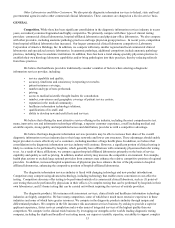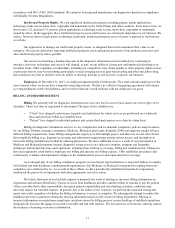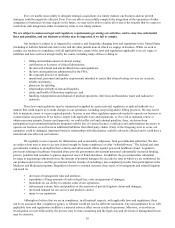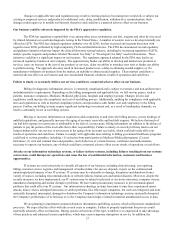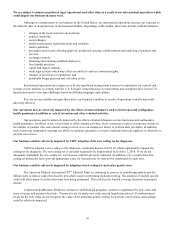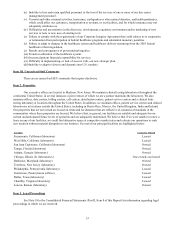Quest Diagnostics 2013 Annual Report Download - page 29
Download and view the complete annual report
Please find page 29 of the 2013 Quest Diagnostics annual report below. You can navigate through the pages in the report by either clicking on the pages listed below, or by using the keyword search tool below to find specific information within the annual report.25
The increased consolidation among health plans also has increased the potential adverse impact of ceasing to be a
contracted provider with any such insurer. The 2010 federal healthcare reform legislation includes provisions, including ones
regarding the creation of healthcare exchanges, that may encourage health insurance plans to increase exclusive contracting.
The American Medical Association CPT® Editorial Panel is continuing its process of establishing analyte specific
billing codes to replace codes that describe procedures used in performing molecular testing. The adoption of analyte specific
codes will allow payers to better determine tests being performed. This could lead to limited coverage decisions or payment
denials. Commercial health plans continue to implement the new codes and issue coverage and payment decisions. Payment
levels for many new codes remain largely unresolved.
We expect continuing efforts to reduce reimbursements, to impose more stringent cost controls and to reduce
utilization of clinical test services. These efforts, including future changes in third-party payer rules, practices and policies, or
ceasing to be a contracted provider to a health plan, may have a material adverse effect on our business.
Our business could be negatively affected if we are unable to continue to improve our efficiency.
Government payers and health insurers have taken steps to control the utilization and reimbursement of healthcare
services, including diagnostic information services; such steps may continue. If we are unable to continue to improve our
efficiency to enable us to mitigate the impact on our profitability of these activities, our business could be negatively affected.
Our new strategic plan may be difficult to implement, and may not be successful, and in either case, it could adversely
impact our business and results of operations.
In November 2012, we announced a new strategic plan for our Company. The success of our new strategy is subject
to both the risks affecting our business generally and the inherent difficulty associated with implementing our new strategies
and is dependent upon the skills, experience and efforts of our management and other employees and our success with third
parties. Restructuring activities involve risks, significant costs and potential liabilities. Among the risks are the following:
disruption of our business or distraction of our employees and management; customer attrition; difficulty recruiting, hiring,
motivating and retaining talented and skilled personnel; increased stock price volatility and changes to our stock price that may
be unrelated to our current results of operations; and executing the strategy in a timely or efficient manner. There is no
assurance that we will be able to successfully implement these strategic initiatives or that implementation of changes will result
in benefits or cost savings at the levels that we anticipate or at all.
Business development activities are inherently risky, and integrating our operations with businesses we acquire may be
difficult and, if unsuccessfully executed, may have a material adverse effect on our business.
We plan selectively to enhance our business from time to time through business development activities, such as
acquisitions, licensing, investments and alliances. However, these plans are subject to the availability of appropriate
opportunities and competition from other companies seeking similar opportunities. Moreover, the success of any such effort
may be affected by a number of factors, including our ability to properly assess and value the potential business opportunity,
and to integrate it into our business. The success of our strategic alliances depends not only on our contributions and
capabilities, but also on the property, resources, efforts and skills contributed by our strategic partners. Further, disputes may
arise with strategic partners, due to conflicting priorities or conflicts of interests.
Each acquisition involves the integration of a separate company that has different systems, processes, policies and
cultures. Integration of acquisitions involves a number of risks including the diversion of management's attention to the
assimilation of the operations of businesses we have acquired, difficulties in the integration of operations and systems and the
realization of potential operating synergies, the assimilation and retention of the personnel of the acquired companies,
challenges in retaining the customers of the combined businesses, and potential adverse effects on operating results. The
process of combining companies may be disruptive to our businesses and may cause an interruption of, or a loss of momentum
in, such businesses as a result of the following difficulties, among others:
• loss of key customers or employees;
• difficulty in standardizing information and other systems;
• difficulty in consolidating facilities and infrastructure;
• failure to maintain the quality or timeliness of services that our Company has historically provided;
• diversion of management's attention from the day-to-day business of our Company as a result of the need to deal
with the foregoing disruptions and difficulties; and
• the added costs of dealing with such disruptions.


